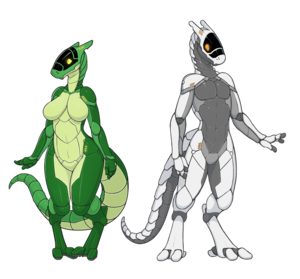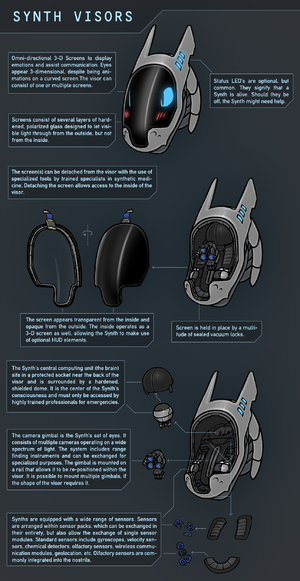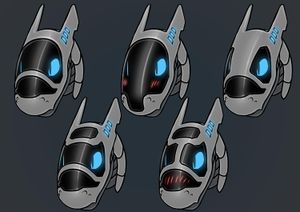Anatomy
Contents
Common Features
Synths can vary widely in appearance, since they come in many sizes, shapes and colours, yet they all have common features that are shared amongst most, but not all Synths.
Synths typically have a long, reptile-like head, featuring a mechanical mouth, a 3D screen visor displaying the Synth's eyes, nostrils for air intake, antenna-like horns and status LED's. Synths tend to be bipedal, but can have snake-like lower bodies, taur-like configurations and many other shapes as well. Their number of limbs can vary, with two arms, two legs and a reptile-like tail being the standard. Hands that are not any form of specialized tools can vary in their number of fingers, with two fingers and one thumb being the standard configuration.
Modularity
One of the main features of any synth is their modularity. Every synth is able to customize their body in various ways. Feet, hands, arms, legs, tails, visors, head shapes, skin style and many other internal parts can be exchanged. Synth parts are typically referred to as modules.
Module exchanges can be done for personal, professional and medical reasons. If a Synth likes the design of a pair of legs they see on display at a store and that pair of legs comes in a size that fits their current body size, the Synth can purchase it, take it home and exchange the old legs for the new ones. Most modules are simple and easy for the Synth to exchange or install themselves, but more complex modules, such as interior modules, require the help of specialists, who typically perform module exchanges at clinics or hospitals.
Fashion
Different Synth modules in themselves are often seen as fashion items. The exterior design of most modules especially carries aesthetic significance. Every producer of parts and modules has a different visual style, with some brands being more popular among synths than others. Notable examples for brands are Virgo Synthetics, Alba Open Labs (ABL) and the Independent Outer Rim Engineering Project (IOREP), as well as a large number of smaller designer studios.
Tools
Many professions carried out by Synths require the use of tools that can be mounted directly to limbs. Some professions have size and equipment requirements that a Synth has to meet before being accepted for the position. An example would be in construction, where Synths have to be tall and strong enough to carry heavy loads, but also to fit the various power tools used during construction. Some professions require the use of precision instruments, like surgery hands with nimble fingers, scalpels, cameras and suction tools built in. The use of tool modules allows Synths to carry out very specialized tasks while they are on the job. If you can think of any specialized tool, there probably is a module that includes it.
Just like with normal tools, most specialized tool modules are owned by companies and given out to their workers as needed. Synths can also personally own tool modules that can be useful at home or in other daily situations. Cooking for organic guests is much easier when you have a cooking hand that includes knives, graters and a potato peeler. Synths who like to tinker with electronics typically own soldering and wire cutting modules.
Despite Synths having the ability to mount tool modules, they don't have to. Due to their humanoid nature, they can use most tools that organics can use as well. In most cases it is easier to simply use a normal hammer than to use an expensive module that does the same thing. Tool modules will usually only be used when it actually ends up making tasks easier than just using regular handheld tools.
Other functions
Many modules don't have a tool or fashion purpose, but still hold a benefit to the Synth or people around them. Examples are scent boxes, battery extensions and voice boxes.
Module changing process
The process of changing modules, or mounting new ones, differs wildly between different kinds of modules. Some parts are easy to exchange, such as minor cosmetic modules that are simply for show. Plating or skin tends to be easily exchangable, simply requiring the new part to be mounted and locked into place. Most Synth parts are designed in a way, that interfacing elements, such as electrical or pneumatic connections, can simply lock into place. Most sockets are standardized and designed with convenience in mind.
Some of the more complex modules however take some time for a Synth to get used to. This particularly is the case for limbs, such as legs and arms. When a Synth aquires a new limb module and mounts it for the first time, their neural networks responsible for motor functions and sensory input are not yet fully connected to the new limb. This is comparable to organics receiving limb transplants. When an organic person receives a hand transplant, it can take a long time for neural connections between the body and the new hand to build up. The hand will only be usable after these nerve connections have been established by the body. With Synths it is a similar, yet faster process. While the physical connection will be there as soon as the module is mounted in the socket, it takes the neural networks within the Synth's brain some time to catch up. This typically takes a day or two, depending on the usage of the limb. The more a Synth practices use of the new limb, the faster the neural networks can get used to it. Not being used to a new limb typically means a lack of motor skills, bad balance and not being able to properly feel the limb in question. The sensation is often described as "ants crawling on your skin". Once a Synth has gotten used to a specific limb, they can always switch back to it and will be used to it again immediately, since the Synth's neural networks remember all limbs they have ever used.
Stigma of changing parts in public
To most Synths the process of changing parts is a very personal affair. It is comparable to an organic person changing clothes. Since it often is connected with embarrassment, it typically is not done in public. Therefore it is common to find changing rooms inside stores that sell Synth modules or any other place where a Synth might have to exchange one part for another, such as work places where particular work modules are required. Synths will typically only let you see them changing parts, if they know you well enough.
Nanites
Synths are, by default, equipped with a small, internal swarm of nanites. Nanites are nano-machines, constructed by the Synth and responsible for handling much of the Synth's metabolism, as well as healing wounds, repairing internal organs and even changing the body's size and stature.
In Addition every Synth is equipped with a blueprint, a piece of software that is exchangeable and allows the Synth's body to change shape over time. Blueprints contain information as to what size and shape a synth wants to be, as well as detailed plans for the build and make-up of internal parts. Blueprints can be exchanged for different ones, depending on the Synth's personal tastes and requirements.
Once a Synth has chosen a blueprint, their internal nanites will go to work and change the Synth's body to be closer to the plans within the blueprint. Should a Synth's actual body deviate from the blueprint, the nanites will strive towards re-building the body towards the plans within the blueprint. That means they will repair damaged parts, will add or remove material from parts or even build completely new ones, should the blueprint dictate it.
The existence of a blueprint and nanites within a Synth's body therefore allows them to change their body shape, size and weight over time, as well as “heal” inflicted damage, very much like wounds healing in organics. Blueprints give nanites a plan on how a Synth's body is supposed to be and the nanites will strive towards that goal. This process still takes time, but also allows Synths to be very flexible when it comes to their stature.
Anatomy in Detail
Head
A Synth's Head is their main, most defining feature. It consists of a lightweight, shell made of layers of lightweight alloys, polymers and carbon fiber, as well as a large quantity of electronics and wiring. The internals of the head are covered by a visor, which allows the synth to see from within, as well as display emotions and other messages on the outside to assist communication. The visor itself consists of an omni-directional 3-D screen, capable of displaying 3-dimentional objects, creating the illusion that these objects exist behind the visor and within the Synth's head. This, in the vast majority of cases, is used to display eyes, to assist the synth with emotional communication and social interactions. The visor is covered by a thin plate of synthetic sapphire, making it hard and difficult to break. Visors are held in place through vacuum locks along the rim, eliminating the need for screws, bolts or glue to hold them in place. Uninstalling a visor requires specialist tools and is usually only done at clinics or hospitals and under anaesthesia.
Visors come in many different shapes and types. Many Synths prefer to have one, large visor, covering most of the facial plate, while others prefer visors consisting of multiple parts. A large number of configurations and shapes is possible, within limiting factors. The cameras and sensors within the head have to be able to see out of the skull well enough in order for the Synth to be able to see. Visors literally are the windows through which Synths see the world and are also the most expressive part of the Synth anatomy.
Behind the Synth visor lies a cavity containing all of the head's internal systems. These systems include exchangable sensory modules, such as sensors for smell, vision, balance and others, as well as the Synth's brain. The brain is fastened into a socket in the back, connecting it to the neural system of the Synth's frame and is protected by a protective, armoured dome. The visual sensors are attached to a gimbal and can be moved around to enable the use of differently shaped visors without obstructing the field of view of the sensors. Use of multiple sets of gimbals and sensors is also possible, if the Synth decides for a visor design without transparent forehead. In such a case the visual sensors are present on either side of the synth's head while still only using one rail for movement.
Many Synth head designs feature horns, antennae or other protruding features. Synthetic hair of different styles is employed as well. These features can have functional purposes, but are mostly of aesthetic use in most cases. Possible functional uses are additional wiring for improved radio wave reception, or even for improved induction charging.
Locomotory System
Synths posses an endoskeleton, including joints and strut-like bones, very similar to those found in organics. In place of organic muscles, they use both pneumatic artificial muscles as well as muscles based on electroactive polymers. Some specialized tools, like arms and legs for construction workers, even make use of hydraulic muscles, due to their higher weight capacity.
Synthetic muscles, for the most part, are arranged in similar ways to those found in organics. This allows Synths to use similar tools, furniture and vehicles to organics, without having to worry about different ergonomics. The synthetic locomotory system is powered directly from the Synths power supply, which allows them to move without the use or oxygen or other elements.
Synth muscles can change size, thanks to the Synth's nanites. If a Synth's blueprint dictates a larger muscle size, than a Synth currently has, their nanites will add material to the muscle tissue, increasing their size over time. This process is relatively slow, but can be accelerated through working the muscles out. Exercising synthetic muscles creates micro-fissures, which allow nanites to add material when fixing the fissures, hence growing muscle with each repair. The process works similar when making muscles smaller.
Synth bones consist of a mixture of lightweight metal alloys and carbon fiber. They are hard and rigid, but flexible enough to not be brittle. Synth bones are able to endure a lot more physical stress than most organic bones, due to the use of strong materials, so fractures are very rare. Synth joints require regular lubrication, which is done by through the use of liquid vessels and nanites, using different types of lubrication depending on the joint. The most common lubricant found in Synth bodies is a fullerene solution.
Inner "Organs"
A Synth's organs are any parts within a Synth body, that are not tissues or part of the locomotory system. The term "organs" can be misleading, since they are synthetic and not organic in nature, yet perform similar tasks to organs within organics. Every Organ performs one or multiple purposes, most of them vital to the functions of the Synth's body.
The Digestive Tract of a Synth consists of multiple digestive chambers linked through peristaltic tubes that move injested materials from the mouth to the digestive chambers. Each chamber is a flexible sack with different means of breaking down materials, making use of corrosive liquids, nano-textured surfaces, Nanites and all sorts of chemical processes. The extracted elements are transported off by nanites and either stored in corresponding storage containers throughout the body, or brought to areas they are needed in at the moment. Materials that can not be fully digested, or that ae not needed at the moment, will be excreted at the end of the digestive tract. This ideally happens at a Synth toilet.
A Synth's Lungs are similar to those found in organics at first glance, in that they are sponge-like sacks that expand to suck in air through the nostrils and down the Synth's air tubes. Functionally they work very differently though. Instead of only filtering oxygen from the air, a Synth's lungs are capable of extracting a variety of elements from gas mixtures they breathe in. The air runs through porous materials and nano filters to extract elements currently needed for the Synth's metabolic processes. The lungs are capable of de- and re-activating these filters according to their body's needs, so only the required elements will be filtered from the air at any given point. As a beneficial side effect of breathing, the chest movement that follows makes Synths feel more "alive" to organics, since it simulates the breathing movements in organics.
Storage Organs are small, pocket-like organs used for storing metabolism materials. Each Synth has two of them on either side of the spine, around the middle of their torso. The centralized position of these organs shortens the distances elements have to be transported through the body. Each storage organs contains multiple flexible compartments, each responsible for storing different materials.
The Capillary System is a system of capillary tubes, filled with fullerene solution, that spans the entire Synth body. The system consists of nodes and tubes that connect these nodes. It is used for transporting nanites and materials through the body. It is somewhat comparable to the organic system of blood vessels, but less expansive and more used for transportation over longer distances. For example nanites can pick up materials from the storage organs around the center of the Synth's torso and use the capillaries to quickly reach a limb by travelling from one node to the next. The nanite will then enter the capillary system of the limb through a capillary port and will be transported further from there until it reaches the destination node from where it will move on its own accord. Fullerene solution is purple, which gives the capillary system and their contents a purple look.
Auxiliary Organs are any organs that exist to help with the function of an external module, but can also be full modules in themselves. Examples of auxiliary organs would be additional motors or pumps required for powering heavy-duty limbs, RCS fuel tanks or storage tanks for flammable liquids for use in welding equipment. Interior standalone modules such as power generators, additional storage organs and even torque wheels fall into the category of auxiliary organs as well.
Skin
Synth skin comes in a variety of textures, colours and consistencies. It is forms a water and air tight layer between the outside world and the inside of the Synth's anatomy. Synth modules such as limbs typically come with their own styles of skin, with different markings and styles, depending on the brand and model. Synth skin can, however, also be exchanged and is just as modular as most other parts of the Synth body. This allows for the installation of specialized type of skin, which are necessary for certain work conditions, such as high radiation environments, in which skin with additional radiation shielding becomes a necessity.
Synth skin is equipped with complex sensors to detect touch, temperature and other input from the environment, making skin a vital part in the Synth's somatosensory system. It allows for proprioception (the sense of motion and movement) and the sensing of haptic input (a part of tactile perception).
Synth skin has the ability to change its colour, using a similar method to that of squids. Being able to pump tiny amounts of pigments into its outer layers, it can display a large variety of patterns and every colour in the visible spectrum. This allows Synths to change the colour of their skin to form simple or complex patterns with the use of colour blueprints. This ability is particularly useful for Synth fashion.
Tissues
Synths bodies don't consist of as many types of tissues as organics do, but they do have their own forms of tissue that are notable.
Battery Tissue is the most common form for a Synth to store energy. Battery tissue is soft, despite consisting of bunched up, microscopic clusters of solid-state batteries. These tissues are comparable to fatty tissues in organics, although the size of the tissue does not correlate with the total amount of energy stored, but instead is an indicator of maximum storable energy.
Muscle tissue is used in the Synth's locomotory system and makes up the walls of the Synth's pneumatic or hydraulic muscles.
Insulation Tissue is a tissue made of clusters of aerogel which serves as heat insulation. This type of tissue is typically found around interior components that are heat sensitive and hence require full thermal insulation. This tissue can also be found on the inside of of Synth skin, to help regulate the overall temperature of the Synth's body.
Metabolism
When discussing the Synth Metabolism, what is usually meant is the way Synths change the size and shape of their bodies without the use of module exchanges. Synths are capable of ingesting food, but not for the same reason organics do it. Synths do not convert ingested materials into energy, since they rely entirely on electric energy stored within their battery tissue and auxiliary batteries. They instead use these materials to maintain the shape of their bodies, or to change it. This happens with the help of the Synth's internal swarm of nanites.
Synths ingest materials such as carbon, iron, copper, gold, silver, manganese, lithium and many others, because those materials are what they are made of themselves. Once chewed and swallowed the ingested materials are transported onwards to the Synth's digestive system, where it is broken down further and seperated into elements by the nanites. The nanites transport small chunks of these elements to their respective storage organs, where they are kept for further use. The transportation of materials through the body happens through the Synth's capillary system.
The materials are then used to maintain or build the Synth's frame. This happens especially when a Synth chooses a blueprint that dictates that their size should increase, since this means that more material needs to be added to the Synth's frame and muscle tissue. In case of muscle growth, the Synth will need to exercise their body to cause microfissures in their muscle tissues. Nanites will then transport materials to the muscle tissues and insert the materials into the microfissures, causing the muscle to grow little by little. The process is similar for the Synth's frame, except that its growth typically takes longer to take place. The process is the same for shrinking of the frame and/or muscles. Nanites remove material from parts that are supposed to shrink and either store them in their respective storage organs or send them on their way to be passed from the Synth's body, if the storage organs are full.
Synths typically need a constant, but very small intake of materials to maintain their bodies and repair small damages within their bodies all the time. Synths will therefore eat on a regular basis, even if they are not changing their body size or shape at the moment.



